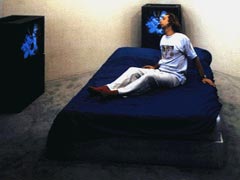|
b. 1966, England
lives in United Kingdom
Studied BA Hon's Fine Art degree under Professor Roy Ascott at
The University of Wales, from September 1985 to June 1988. Post-graduate
MFA degree at The University of Reading, England, from Oct 1989
to June 1991. Awarded the Prix Ars Electronica "Golden Nica",
in the category of interactive art, for the hypermedia installation
"Think about the People now", in Linz, Austria, September
1991. Worked as an Artist in Residence and produced the ISDN video
conference installation "Telematic Vision" at the Center
for Art and Media technology (ZKM) in Karlsruhe, Germany, from February
to November 1993. Received the "Sparkey Award" from the
Interactive Media Festival in Los Angeles, for the telepresent video
installation "Telematic Dreaming", In June 1994. Reader
in Creative Technology at The University of Salford, Research Centre
for Art & Design, Manchester, England, since June 2000.
Paul Sermon interview at the Ars Electronica Center, Linz, January
1997
Paul, how does "Telematic
Dreaming" exactly function and what's the kick of the project
in your opinion?
"Telematic Dreaming" functions like a mirror that reflects your
image within another person's reality. The basic technical system
consists of a camera situated above a queen-size bed. The camera
receives an overhead view of the bed, which is fortunately of equal
ratio to that of video format. The image of the bed, and someone
lying on it, is sent via ISDN lines and teleconferencing systems
to a video projector situated above another bed in a geographically
distant location. The live image is projected down on to the bed,
and so with it the live, life-size image of the person. Another
video camera situated next to the video projector sends an image
of the projection, and the second person lying on the bed under
the projection, back to the first bed. "Telematic Dreaming" raises
and addresses many questions, but above all, it is the question
of consciousness that interests me most. The visual image of the
bodily form on a bed allows the user's consciousness to race back
and forth between the cause and effect of their remote and local
body form. It is a means of extending consciousness through a technological
extension of the body.
How important is the role of the spectator?
The spectator or user is central to the installation. Without them
the bed is an empty space of potential. When entering the bed space
the user becomes the voyeur of their own spectacle.
Present/Absent--the bodies "meet" somewhere in the digital network.
Does "Telematic dreaming" create a new relationship with the body?
The bodily form encapsulates our consciousness. I believe it is
possible to extend our consciousness beyond it, as in a telephone
conversation or email message, but we are a long way off the conception
of it. The bodily form as a signifier is still necessary to identify
and locate our consciousness at a distance. Therefore I am not concerned
with escaping my form but rather to look back and observe it at
a distance from the outside.
Touching as looking, looking as touching--what does this concentration
on one sense mean to you?
The human senses are as malleable as is the language that defines
them. All sensory input definitions are a construct of language,
which itself constructs our reality. Just because language dictates
that we touch with our hands and see with our eyes doesn't mean
that's all. It's absolutely conceivable that we can also see with
our hands and touch with our eyes in just the same way. It's a mater
of manipulation and definition.
http://www.artdes.salford.ac.uk/sermon/dream/
|

